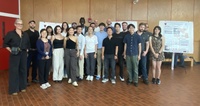Our group’s primary research focus is on understanding biological design. This includes nature’s mechanism for mechanotransduction. In this regard, we are interested in how extracellular matrix and cytoskeletal architecture potentiate and modulate the activation of mechanochemical and mechanoelectrical signaling pathways and genetic programs in cardiac, neural, and vascular smooth muscle cells and tissues. In order to study these mechanisms at different spatial scales, we use cellular and tissue engineering techniques that allow us to build custom-designed tissue constructs as experimental preparations.
Our group also has a growing effort in biologically-inspired design. This includes our work with electroactive polymer actuators, bio-inspired photonic systems, nanotextiles, and cell and tissue self-assembly as a system for rapid-prototyping of nonbiological systems.
Current areas of active research include:
Mechanotransduction – the role of mechanical stress, cell shape, and cell architecture on cell function.
Tissue Engineering – development of tissue grafts and scaffolds with unique structures and functions.
Brain Injury – investigating the mechanisms of traumatic brain injury at a cell and tissue scale.
Nanotextiles – developing new techniques for mimicking ECM networks for regenerative medicine and other industrial applications.
Microdevices – designing and building microscale soft biological constructs which retain their unique biological functionalities.

